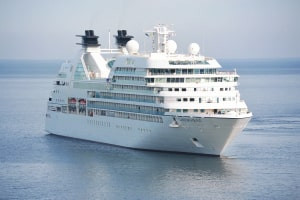When building a ship, what calculations need to be made and how should the structure be crafted? Throughout this course, you will answer these questions along with other matters of a vessel's stability. You will be introduced to the history of adaptive and variant designs in ships as well as the contributions of computational fluid dynamics and ship model testing. You will cover basic vessel calculations, the Wetted Surface Area (WSA), hydrostatic pressure and the four coefficients of importance needed to understand the basics of ship stability along with their formulas. What other rules can be used to calculate the area and volume of a vessel? Simpson's rules are also covered as you examine the history behind these concepts.
As you continue your studies, you will be introduced to the concepts and definition of ‘buoyancy’, together with the principle of floatation. You will learn about the concepts and characteristics of displacement tonnage, along with the two constituents of displacement: light and load displacement. The concepts and functions of deadweight will also be covered in this course. Fresh watermarks for the ship, hydrostatic curves, the functions of hydrostatic tables as well as the concept and functions of the hydrostatic draft are all discussed. The principles of transverse statical stability will also be taught in this course.
Furthermore, this course will help you get familiar with the illustration, construction and interpretation of the curve of statical stability. You will also be familiar with the concepts and differences between stiff and tender vessels. This course will teach you about the shift in the centre of gravity, free surface correction, Moment to Change Trim (MCTI), SOLAS general requirements and much more. The concepts of bilging, permeability and damage control planning will be discussed as well. You will also be familiar with the functions and operations of hydraulically operated watertight doors as well as the cross-flooding arrangement. For those interested in the architecture of a ship and how to keep it stable upon the open water, this course will be a great resource. Register for this course and start your next learning journey today.
What You Will Learn In This Free Course
View All Learning Outcomes View Less All Alison courses are free to enrol, study, and complete. To successfully complete this Diploma course and become an Alison Graduate, you need to achieve 80% or higher in each course assessment.
Once you have completed this Diploma course, you have the option to acquire an official Diploma, which is a great way to share your achievement with the world.
Your Alison certificate is:
- Ideal for sharing with potential employers.
- Great for your CV, professional social media profiles, and job applications.
- An indication of your commitment to continuously learn, upskill, and achieve high results.
- An incentive for you to continue empowering yourself through lifelong learning.
Alison offers 2 types of Diploma for completed Diploma courses:
- Digital Diploma: a downloadable Diploma in PDF format immediately available to you when you complete your purchase.
- Physical Diploma: a physical version of your officially branded and security-marked Diploma
All Diplomas are available to purchase through the Alison Shop. For more information on purchasing Alison Diploma, please visit our FAQs. If you decide not to purchase your Alison Diploma, you can still demonstrate your achievement by sharing your Learner Record or Learner Achievement Verification, both of which are accessible from your Account Settings.











 Avg. Hours
Avg. Hours  Contains Video
Contains Video  CPD Accredited
CPD Accredited 
 Total XP:
Total XP: 
 Knowledge & Skills You Will Learn
Knowledge & Skills You Will Learn 






